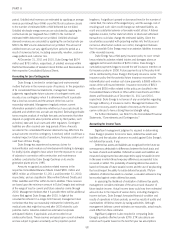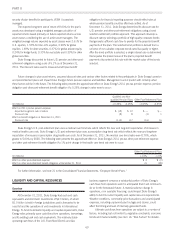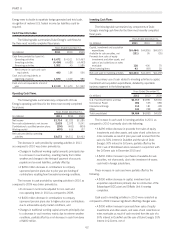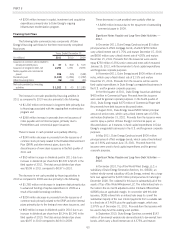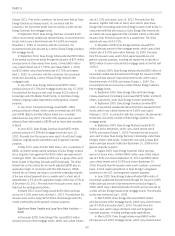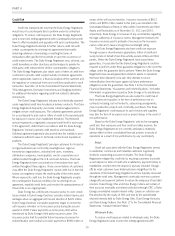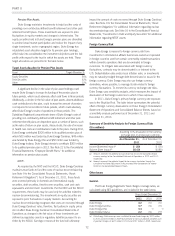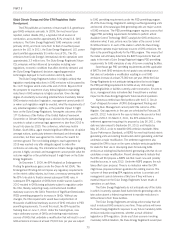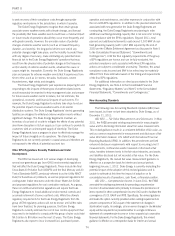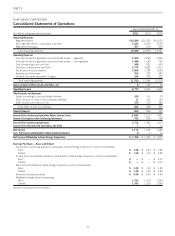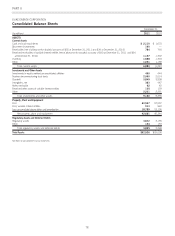Duke Energy 2011 Annual Report Download - page 88
Download and view the complete annual report
Please find page 88 of the 2011 Duke Energy annual report below. You can navigate through the pages in the report by either clicking on the pages listed below, or by using the keyword search tool below to find specific information within the annual report.
PART II
(g) The table above excludes certain obligations discussed herein related to amounts recorded within Deferred Credits and Other Liabilities on the Consolidated Balance Sheets due to the
uncertainty of the timing and amount of future cash flows necessary to settle these obligations. The amount of cash flows to be paid to settle the asset retirement obligations is not known
with certainty as Duke Energy may use internal resources or external resources to perform retirement activities. As a result, cash obligations for asset retirement activities are excluded
from the table above. However, the vast majority of asset retirement obligations will be settled beyond 2014. Asset retirement obligations recognized on the Consolidated Balance Sheets
total $1,936 million and the fair value of the NDTF, which will be used to help fund these obligations, is $2,060 million at December 31, 2011. The table above excludes reserves for
litigation, environmental remediation, asbestos-related injuries and damages claims and self-insuranceclaims(seeNote5totheConsolidatedFinancial Statements, “Commitments and
Contingencies”) because Duke Energy is uncertain as to the timing of when cash payments will be required. Additionally, the table above excludes annual insurance premiums that are
necessary to operate the business, including nuclear insurance (see Note 5 to the Consolidated Financial Statements, “Commitments and Contingencies”), funding of pension and other
post-retirement benefit plans (see Note 21 to the Consolidated Financial Statements, “Employee Benefit Plans”) and regulatory liabilities (see Note 4 to the Consolidated Financial
Statements, “Regulatory Matters”) because the amount and timing of the cash payments are uncertain. Also excluded are Deferred Income Taxes and Investment Tax Credits recorded on
the Consolidated Balance Sheets since cash payments for income taxes are determined based primarily on taxable income for each discrete fiscal year. Additionally, amounts related to
uncertain tax positions are excluded from the table above due to uncertainty of timing of future payments.
(h) Current liabilities, except for current maturities of long-term debt, and purchase obligations reflected in the Consolidated Balance Sheets, have been excluded from the above table.
Quantitative and Qualitative Disclosures About Market Risk
Risk Management Policies
TheDukeEnergyRegistrantsareexposedtomarketrisks
associated with commodity prices, credit exposure, interest rates,
equity prices and foreign currency exchange rates. Management has
established comprehensive risk management policies to monitor and
manage these market risks. Duke Energy’s Chief Executive Officer
and Chief Financial Officer are responsible for the overall approval of
market risk management policies and the delegation of approval and
authorization levels. The Finance and Risk Management Committee
of the Board of Directors receives periodic updates from the Chief Risk
Officer and other members of management on market risk positions,
corporate exposures, credit exposures and overall risk management
activities. The Chief Risk Officer is responsible for the overall
governance of managing credit risk and commodity price risk,
including monitoring exposure limits.
Commodity Price Risk
The Duke Energy Registrants are exposed to the impact of
market fluctuations in the prices of electricity, coal, natural gas and
other energy-related products marketed and purchased as a result of
its ownership of energy related assets. The Duke Energy Registrants’
exposure to these fluctuations is limited by the cost-based regulation
ofitsU.S.FranchisedElectricandGasoperationsastheseregulated
operations are typically allowed to recover certain of these costs
through various cost-recovery clauses, including fuel clauses. While
there may be a delay in timing between when these costs are
incurred and when these costs are recovered through rates, changes
from year to year generally do not have a material impact on
operating results of these regulated operations.
Price risk represents the potential risk of loss from adverse
changes in the market price of electricity or other energy
commodities. The Duke Energy Registrants’ exposure to commodity
price risk is influenced by a number of factors, including contract
size, length, market liquidity, location and unique or specific contract
terms. The Duke Energy Registrants employ established policies and
procedures to manage the risks associated with these market
fluctuations, which may include using various commodity derivatives,
such as swaps, futures, forwards and options. For additional
information, see Note 14 to the Consolidated Financial Statements,
“Risk Management, Derivative Instruments and Hedging Activities.”
Validation of a contract’s fair value is performed by an internal
group separate from the Duke Energy Registrants’ deal origination
areas. While the Duke Energy Registrants use common industry
practices to develop their valuation techniques, changes in their
pricing methodologies or the underlying assumptions could result in
significantly different fair values and income recognition.
Hedging Strategies.
The Duke Energy Registrants closely monitor the risks
associated with commodity price changes on their future operations
and, where appropriate, use various commodity instruments such as
electricity, coal and natural gas forward contracts to mitigate the effect
of such fluctuations on operations, in addition to optimizing the value
of the non-regulated generation portfolio. Duke Energy’s primary use
of energy commodity derivatives is to hedge the generation portfolio
against exposure to the prices of power and fuel.
The majority of derivatives used to manage the Duke Energy
Registrants commodity price exposure are either not designated as a
hedge or do not qualify for hedge accounting. These instruments are
referred to as undesignated contracts. Mark-to-market changes for
undesignated contracts entered into by regulated businesses are
reflected as a regulatory asset or liability on the Consolidated Balance
Sheets. Undesignated contracts entered into by unregulated
businesses are marked-to-market each period, with changes in the
fair value of the derivative instruments reflected in earnings.
Certain derivatives used to manage the Duke Energy Registrants’
commodity price exposure are accounted for as either cash flow
hedges or fair value hedges. To the extent that instruments accounted
for as hedges are effective in offsetting the transaction being hedged,
there is no impact to the Consolidated Statements of Operations until
after delivery or settlement occurs. Accordingly, assumptions and
valuation techniques for these contracts have no impact on reported
earnings prior to settlement. Several factors influence the effectiveness
of a hedge contract, including the use of contracts with different
commodities or unmatched terms and counterparty credit risk. Hedge
effectiveness is monitored regularly and measured at least quarterly.
In addition to the hedge contracts described above and recorded
on the Consolidated Balance Sheets, the Duke Energy Registrants enter
into other contracts that qualify for the NPNS exception. When a
contract meets the criteria to qualify as an NPNS, U.S. Franchised
Electric and Gas and Commercial Power apply such exception. Income
recognition and realization related to NPNS contracts generally coincide
with the physical delivery of power. For contracts qualifying for the
NPNS exception, no recognition of the contract’s fair value in the
Consolidated Financial Statements is required until settlement of the
contract as long as the transaction remains probable of occurring.
68


